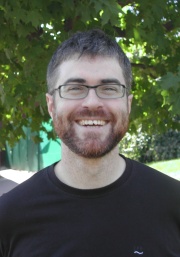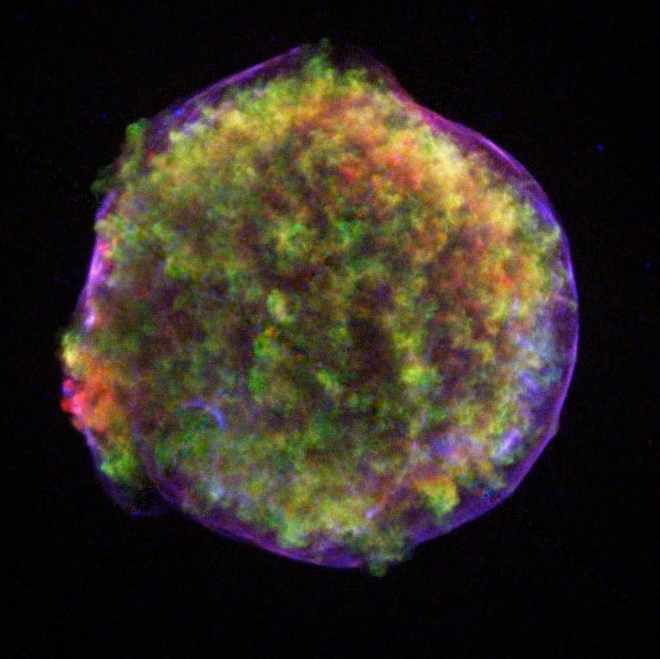About Me

I am a Research Fellow at Tel-Aviv University and the Weizmann Institute of Science in Israel. At TAU, I work at the Department of Astrophysics. At WIS, I am a member of the Experimental Astrophysics Group. I have been in Israel since October of 2009.
|
Contact InformationCarles Badenes
School of Physics and Astronomy, Benoziyo Center for Astrophysics, |
Research
My research focuses on Type Ia supernova explosions, their binary progenitor systems, and the supernova remnants (SNRs) that they leave behind. Below you can find information on some of my research projects. You can find a complete list of all my publications here (from NASA ADS) and all my preprints here (from the arXiv archive). If you are interested in SNRs in general, I wrote a short review for the 10th anniversary Chandra conference: Badenes 2010, PNAS 107, 7141.
Type Ia SN Explosion Physics from SNRs

Over the years, I have developed a set of models to analyze the X-ray emission from shocked SN ejecta in young Type Ia SNRs. Using these models, it is possible to interpret the X-ray spectra of SNRs like the Tycho SNR (pictured here to the left) obtained with Chandra or XMM-Newton in terms of variables that are relevant for the physics of Type Ia SNe, like the explosion mechanism and the amount of 56Ni synthesized. In some cases, the results can be verified using light echoes from the SN itself (see the press release for SNR 0509-67.5). These X-ray models are publicly available, please contact me if you are interested in using them for your own research.
Relevant Publications:
- My PhD thesis (2004): The most complete description of the models. It's 170 pages long - don't say I did not warn you!
- Badenes, Bravo, Borkowski & Domínguez 2003, ApJ 593, 358: General explanation of the models.
- Badenes, Borkowski & Bravo 2005, ApJ 624, 198: More specific details.
- Badenes, Borkowski, Hughes, Hwang & Bravo 2006, ApJ 645, 1373: Application to the Tycho SNR.
- Badenes, Hughes, Cassam-Chenai & Bravo 2008, ApJ 680, 1149: Application to SNR 0509-67.5 in the LMC.
Type Ia SN Progenitors from SNRs

Because they are much closer than any SN that can be observed from Earth, young SNRs can constrain the properties of Type Ia SN progenitors in many unique ways. One spectacular example is the Kepler SNR (pictured here to the left), a Type Ia object that appears to be interacting with circumstellar material expelled by its progenitor (for more information on this, see the press release and the paper). A few other techniques that I have worked on are:
SNR Dynamics: The radii, shock velocities, and ionization timescales of Type Ia SNRs with known ages can be used to constrain the mass-loss histories of their Type Ia SN progenitors. Relevant Publication: Badenes, Hughes, Bravo & Langer 2007, ApJ 662, 472.
Mn and Cr lines in the X-ray Spectra of SNRs: We have proposed a new method to measure the metallicity of Type Ia SN progenitors directly using weak emission lines from Mn and Cr in the X-ray spectra of bright SNRs like Tycho and Kepler. Koji Mukai put together a nice feature about this work for the Suzaku Learning center, which you can find here. Relevant Publication: Badenes, Bravo & Hughes 2008, ApJ 680, L33.
Stellar Populations Around SNRs: By studying the resolved stellar populations around young Type Ia SNRs, it is possible to constrain the properties of their progenitors. This can be done either for a few specific objects, or for the entire SNR population in galaxies like the Magellanic Clouds. The delay time distribution - the SN rate as a function of time following a hypothetical brief burst of star formation - can be derived in this way, provided the evolution of SNRs in the interstellar medium, and in particular, the distribution of sizes, is understood at least at a basic level. Kurtis Williams published a nice feature about this work in his blog.
Relevant Publications:
- Badenes, Harris, Zaritsky & Prieto 2009, ApJ 700, 727: Stellar populations around the eight smallest (and presumably youngest) SNRs in the LMC.
- Badenes, Maoz & Draine 2010, MNRAS 407, 1301: A physical model to explain the size distribution of SNRs in the Magellanic Clouds.
- Maoz & Badenes 2010, MNRAS 407, 1314: Derivation of the SN rates and delay time distribution in the Magellanic Clouds.
SWARMS: Searching for Type Ia SN Progenitors with the Sloan Digital Sky Survey
Coming soon.
Relevant Publications:
Collaborators
- Kazik Borkowski (NCSU, Raleigh, NC) [5]
- Eduardo Bravo (UPC, Barcelona, Spain) [9]
- Avishay Gal-Yam (Weizmann Institute, Israel) [1]
- Jack Hughes (Rutgers University, NJ) [6]
- Una Hwang (NASA-GSFC, Greenbelt, MD) [3]
- Martin Laming (NRL, Washington DC) [2]
- Dan Maoz (Tel-Aviv University, Israel) [2]
- José Luis Prieto (Carnegie Observatories) [1]
- Armin Rest (Harvard) [1]
- Dennis Zaritsky (University of Arizona, Tucson AZ) [1]
Talks
Here you can find the pdf files for some talks I have given in the past. I make them available in the hope that someone will find them useful. I make an effort to reference the work of my colleagues properly; if you find that your work is not referenced correctly in these viewgraphs, or you have any questions about the content of the presentations, please contact me.
- IAS Coffee (review of Type Ia models). IAS, Princeton, Feb 6, 2008.
- Wunch Talk. Princeton, Jan 30, 2008.
- Massive Stars Workshop. Lorentz Center Leiden, Aug 7, 2007.
- Endpoints and Interactions Workshop (AAS meeting). Hawaii, May 24, 2007.
- Paths to Exploding Stars conference. KITP Santa Barbara, Mar 22, 2007.
- Physics of Type Ia SNe program. KITP Santa Barbara, Feb 8, 2007.
- UT Austin Dept. of Astronomy Seminar Dec 7, 2006.
- Princeton ISM Seminar Nov 27, 2006.
- Chandra Fellows Symposium Oct 13, 2006.
- SN and GRB Remnants conference. KITP Santa Barbara, Feb 10, 2006.
- New Jersey StarQuest 2005 Jun 4, 2005 (general audiences).
Personal
- Compulsive reader. A little bit of everything, including science fiction, fantasy, history and drama. Here is a list of what I have been reading lately.
- Avid music listener. Also a little bit of everything, with emphasis on rock, blues, good pop, alt-country and celtic music.
- I like some movies a lot. Most of my favorite movies are classics, like 'The Quiet Man' or 'All About Eve'. Incidentally, I share a birthday with the (IMHO) greatest film director of all time: Mr John Ford.
- Born on the shore of the Mediterranean Sea. To be specific, in a town called Castellò de la Plana, although I consider my roots to be in the village of Atzeneta del Maestrat, where my father's family comes from. I have lived for most of my life in Barcelona, which I think is a very beautiful and fascinating city.
- Carlos or Carles? A lot of people ask me whether my name is Carlos or Carles. The answer is that it is both, it just depends on what language you are using. In Spanish, it is written Carlos and pronounced [karlos] (in the SAMPA phonetic alphabet, here is a chart). This is the version of my name that appears in my passport and all other official documents. In Catalan, it is written Carles and pronounced [karl@s]. This is how most of my friends call me, and is the form that I use to sign scientific papers. But I answer to both. So now you know.